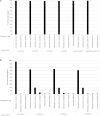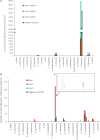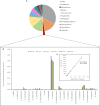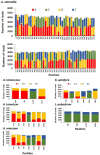The Application of Nanopore Sequencing Technology to the Study of Dinoflagellates: A Proof of Concept Study for Rapid Sequence-Based Discrimination of Potentially Harmful Algae
- PMID: 32457722
- PMCID: PMC7227484
- DOI: 10.3389/fmicb.2020.00844
The Application of Nanopore Sequencing Technology to the Study of Dinoflagellates: A Proof of Concept Study for Rapid Sequence-Based Discrimination of Potentially Harmful Algae
Abstract
Harmful algal blooms (HABs) are a naturally occurring global phenomena that have the potential to impact fisheries, leisure and ecosystems, as well as posing a significant hazard to animal and human health. There is significant interest in the development and application of methodologies to study all aspects of the causative organisms and toxins associated with these events. This paper reports the first application of nanopore sequencing technology for the detection of eukaryotic harmful algal bloom organisms. The MinION sequencing platform from Oxford Nanopore technologies provides long read sequencing capabilities in a compact, low cost, and portable format. In this study we used the MinION to sequence long-range PCR amplicons from multiple dinoflagellate species with a focus on the genus Alexandrium. Primers applicable to a wide range of dinoflagellates were selected, meaning that although the study was primarily focused on Alexandrium the applicability to three additional genera of toxic algae, namely; Gonyaulax, Prorocentrum, and Lingulodinium was also demonstrated. The amplicon generated here spanned approximately 3 kb of the rDNA cassette, including most of the 18S, the complete ITS1, 5.8S, ITS2 and regions D1 and D2 of the 28S. The inclusion of barcode genes as well as highly conserved regions resulted in identification of organisms to the species level. The analysis of reference cultures resulted in over 99% of all sequences being attributed to the correct species with an average identity above 95% from a reference list of over 200 species (see Supplementary Material 1). The use of mock community analysis within environmental samples highlighted that complex matrices did not prevent the ability to distinguish between phylogenetically similar species. Successful identification of causative organisms in environmental samples during natural toxic events further highlighted the potential of the assay. This study proves the suitability of nanopore sequencing technology for taxonomic identification of harmful algal bloom organisms and acquisition of data relevant to the World Health Organisations "one health" approach to marine monitoring.
Keywords: MinION; alexandrium; dinoflagellate; eDNA; harmful algal bloom; nanopore sequencing; sequencing.
Copyright © 2020 Hatfield, Batista, Bean, Fonseca, Santos, Turner, Lewis, Dean and Martinez-Urtaza.
Figures






References
-
- Anderson D. M., Glibert P. M., Burkholder J. M., Anderson D. M., Glibert P. M., Burkholder J. M., et al. (2019). Harmful Algal Blooms and Eutrophication?: Nutrient Sources, Composition, and Consequences Coastal Waters?: Global Patterns of Cause and Effect (Aug., 2002). Seattle, WA: Coastal and Estuarine Research Federation Stable, 704–726.
-
- Bauder A. G., Cembella A. D., Bricelj V. M., Quilliam M. A. (2001). Uptake and fate of diarrhetic shellfish poisoning toxins from the dinoflagellate Prorocentrum lima in the bay scallop Argopecten irradians. Mar. Ecol. Prog. Ser. 213 39–52. 10.3354/meps213039 - DOI
LinkOut - more resources
Full Text Sources

